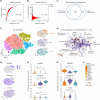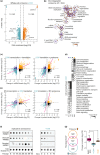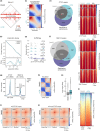Rapid and synchronous chemical induction of replicative-like senescence via a small molecule inhibitor
- PMID: 38196311
- PMCID: PMC11019153
- DOI: 10.1111/acel.14083
Rapid and synchronous chemical induction of replicative-like senescence via a small molecule inhibitor
Abstract
Cellular senescence is acknowledged as a key contributor to organismal ageing and late-life disease. Though popular, the study of senescence in vitro can be complicated by the prolonged and asynchronous timing of cells committing to it and by its paracrine effects. To address these issues, we repurposed a small molecule inhibitor, inflachromene (ICM), to induce senescence to human primary cells. Within 6 days of treatment with ICM, senescence hallmarks, including the nuclear eviction of HMGB1 and -B2, are uniformly induced across IMR90 cell populations. By generating and comparing various high throughput datasets from ICM-induced and replicative senescence, we uncovered a high similarity of the two states. Notably though, ICM suppresses the pro-inflammatory secretome associated with senescence, thus alleviating most paracrine effects. In summary, ICM rapidly and synchronously induces a senescent-like phenotype thereby allowing the study of its core regulatory program without confounding heterogeneity.
Keywords: 3D genome organization; SASP; cellular ageing; chromatin; senescence; single cell genomics.
© 2024 The Authors. Aging Cell published by Anatomical Society and John Wiley & Sons Ltd.
Conflict of interest statement
WW is cofounder of Cygenia GmbH (
Figures






Similar articles
-
Molecular Aspects of Senescence and Organismal Ageing-DNA Damage Response, Telomeres, Inflammation and Chromatin.Int J Mol Sci. 2021 Jan 8;22(2):590. doi: 10.3390/ijms22020590. Int J Mol Sci. 2021. PMID: 33435578 Free PMC article. Review.
-
Keeping the senescence secretome under control: Molecular reins on the senescence-associated secretory phenotype.Exp Gerontol. 2016 Sep;82:39-49. doi: 10.1016/j.exger.2016.05.010. Epub 2016 May 25. Exp Gerontol. 2016. PMID: 27235851 Review.
-
HMGB1 coordinates SASP-related chromatin folding and RNA homeostasis on the path to senescence.Mol Syst Biol. 2021 Jun;17(6):e9760. doi: 10.15252/msb.20209760. Mol Syst Biol. 2021. PMID: 34166567 Free PMC article.
-
Cellular senescence in ageing, age-related disease and longevity.Curr Vasc Pharmacol. 2014;12(5):698-706. doi: 10.2174/1570161111666131219094045. Curr Vasc Pharmacol. 2014. PMID: 24350932 Review.
-
Tumor suppressor and aging biomarker p16(INK4a) induces cellular senescence without the associated inflammatory secretory phenotype.J Biol Chem. 2011 Oct 21;286(42):36396-403. doi: 10.1074/jbc.M111.257071. Epub 2011 Aug 31. J Biol Chem. 2011. PMID: 21880712 Free PMC article.
Cited by
-
Selective Sorting of Senescent Cell Subpopulations Compatible with Downstream Genomics Applications.Methods Mol Biol. 2025;2906:45-55. doi: 10.1007/978-1-0716-4426-3_3. Methods Mol Biol. 2025. PMID: 40082349
-
Single-cell morphology encodes functional subtypes of senescence in aging human dermal fibroblasts.Sci Adv. 2025 Apr 25;11(17):eads1875. doi: 10.1126/sciadv.ads1875. Epub 2025 Apr 25. Sci Adv. 2025. PMID: 40279419 Free PMC article.
References
-
- Acosta, J. C. , Banito, A. , Wuestefeld, T. , Georgilis, A. , Janich, P. , Morton, J. P. , Athineos, D. , Kang, T. W. , Lasitschka, F. , Andrulis, M. , Pascual, G. , Morris, K. J. , Khan, S. , Jin, H. , Dharmalingam, G. , Snijders, A. P. , Carroll, T. , Capper, D. , Pritchard, C. , … Gil, J. (2013). A complex secretory program orchestrated by the inflammasome controls paracrine senescence. Nature Cell Biology, 15(8), 978–990. - PMC - PubMed
-
- Baker, D. J. , Childs, B. G. , Durik, M. , Wijers, M. E. , Sieben, C. J. , Zhong, J. , Saltness, R. A. , Jeganathan, K. B. , Verzosa, G. C. , Pezeshki, A. , Khazaie, K. , Miller, J. D. , & Van Deursen, J. M. (2016). Naturally occurring p16Ink4a‐positive cells shorten healthy lifespan. Nature, 530, 184–189. - PMC - PubMed
-
- Browder, K. C. , Reddy, P. , Yamamoto, M. , Haghani, A. , Guillen, I. G. , Sahu, S. , Wang, C. , Luque, Y. , Prieto, J. , Shi, L. , Shojima, K. , Hishida, T. , Lai, Z. , Li, Q. , Choudhury, F. K. , Wong, W. R. , Liang, Y. , Sangaraju, D. , Sandoval, W. , … Izpisua Belmonte, J. C. (2022). In vivo partial reprogramming alters age‐associated molecular changes during physiological aging in mice. Nature Aging, 2, 243–253. - PubMed
Publication types
MeSH terms
Grants and funding
LinkOut - more resources
Full Text Sources
Medical
Molecular Biology Databases

